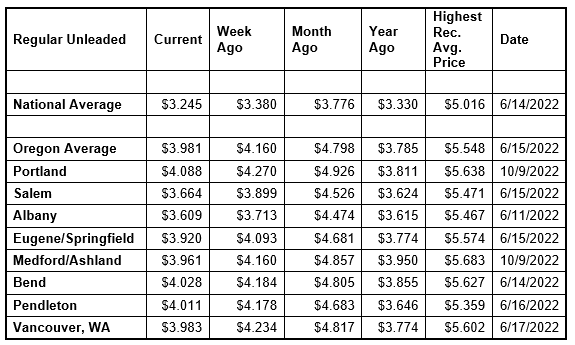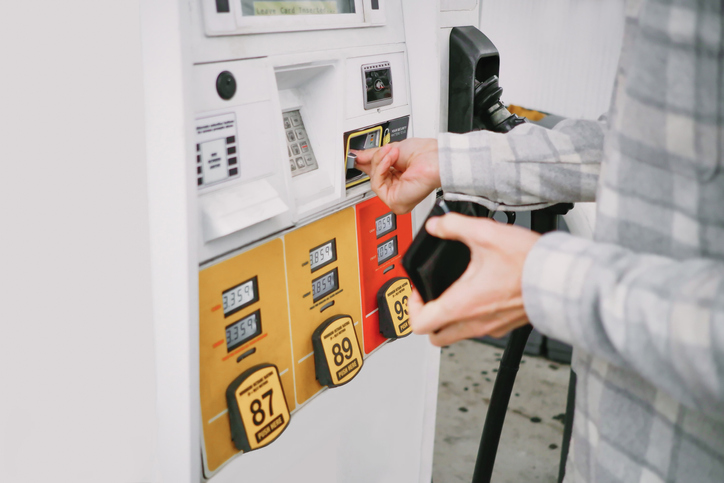For the first time since Feb. 23, the Oregon average for regular unleaded has dropped below $4 a gallon. Gas prices continue to fall in all 50 states again this week. Lower crude oil prices, lackluster demand for gas, and growing gasoline stocks are the major drivers. For the week, the national average for regular loses 14 cents to $3.25 a gallon. The Oregon average tumbles 18 cents to $3.98. Oregon has the ninth-largest weekly drop and fifth-largest monthly drop for a state in the nation.

As of last Thursday, December 8, the national average dipped below its year-ago price for the first time in 654 days. As of today, 34 states have averages that are cheaper than last year. The Oregon average is 20 cents more than a year ago. AAA expects that Oregon and all other states except Alaska, Hawaii and Nevada will see gasoline deflation in the coming weeks.
“The seasonal pattern of less driving due to shorter days and winter weather along with lower crude oil prices are causing pump prices to fall. AAA expects the national average will drop below $3 a gallon in the coming weeks,” says Marie Dodds, public affairs director for AAA Oregon/Idaho.
This month crude oil fell below $72 per barrel, the lowest price December 2021. This month, West Texas Intermediate, the U.S. benchmark, has ranged between about $71.50 and $81 per barrel. In November, WTI ranged between $76 and $92 per barrel. In October, crude ranged between $82 and $92 per barrel. In September, crude prices ranged between about $76 and $88 per barrel. Crude reached a recent high of $122.11 per barrel on June 8. The all-time high for WTI crude oil is $147.27 in July 2008.
Crude prices rose dramatically leading up to and in the first few months of Russia’s invasion of Ukraine. Russia is one of the world’s top oil producers and its involvement in a war causes market volatility, and sanctions imposed on Russia by the U.S. and other western nations resulted in tighter global oil supplies. Oil supplies were already tight around the world as demand for oil increased as pandemic restrictions eased. A year ago, crude was around $71 per barrel compared to $76 today.
Crude oil is the main ingredient in gasoline and diesel, so pump prices are impacted by crude prices on the global markets. On average, about 56% of what we pay for in a gallon of gasoline is for the price of crude oil, 20% is refining, 11% distribution and marketing, and 14% are taxes, according to the U.S. Energy Information Administration.
Demand for gasoline in the U.S. is holding steady for the third consecutive week at about at 8.3 million b/d for the week ending December 2. This compares to 8.9 million b/d at this time last year. Total domestic gasoline stocks rose significantly by 5.3 million bbl to 219.1 million bbl. Increasing supply and lower gasoline demand will push pump prices lower barring any supply glitches.
Quick stats
Pump prices are lower this week in all 50 states and the District of Columbia. Alaska (-27 cents) has the largest weekly drop, followed by Montana (-27 cents), California (-21 cents), Nevada (-20 cents), and Michigan (-19 cents). Oregon (-18 cents) has the ninth-largest weekly drop. Hawaii (-4 cents) has the smallest weekly decline.
Hawaii ($5.14) is the state with the most expensive gas in the nation for the third week in a row and is the only state with an average at or above $5 a gallon. California ($4.51) is second and Nevada ($4.24) is third. This week four states have averages at or above $4, 31 states and the District of Columbia have averages in the $3-range, and 15 states have averages below $3 a gallon.
The cheapest gas in the nation is in Texas ($2.69) and Oklahoma ($2.70). For the 101st week in a row, no state has an average below $2 a gallon.
The difference between the most expensive and least expensive states is $2.46 which continues to be stark.
All 50 states and the District of Columbia have lower prices now than a month ago. The national average is 53 cents less and the Oregon average is 82 cents less than a month ago. Oregon has the fifth-largest monthly decrease in the nation. California (-93 cents) and Alaska (-91 cents) have the largest monthly decline. Hawaii (-5 cents) has the smallest.
Oregon is one of 16 states and the District of Columbia with higher prices now than a year ago. The national average is nine cents less and the Oregon average is 20 cents more than a year ago. This is the fifth-largest year-over-year increase in the nation. Hawaii (+81 cents), Nevada (+36 cents), Washington (+21 cents), and Pennsylvania (+20 cents) have the largest yearly gains. Colorado (-40 cents) has the biggest year-over-year decline.






